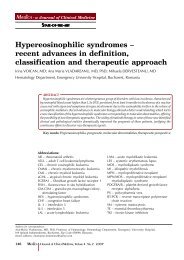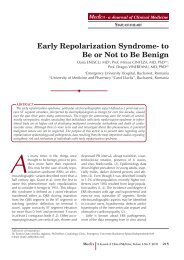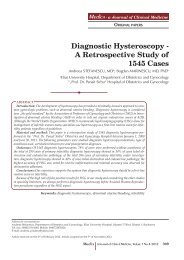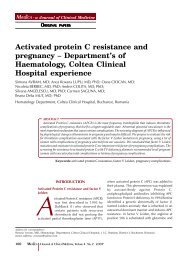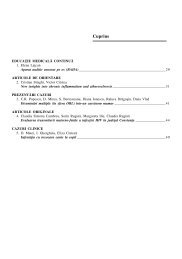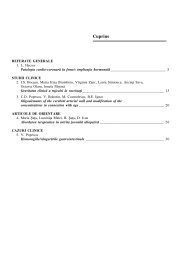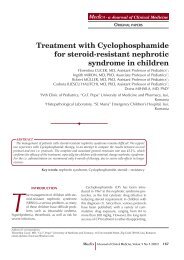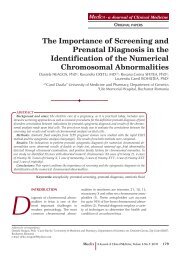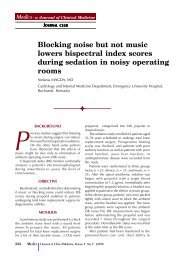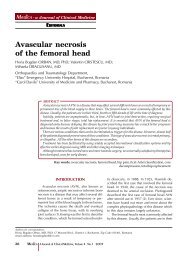The use of antibiotics in traumatology and orthopaedic surgery
The use of antibiotics in traumatology and orthopaedic surgery
The use of antibiotics in traumatology and orthopaedic surgery
Create successful ePaper yourself
Turn your PDF publications into a flip-book with our unique Google optimized e-Paper software.
THE UUSE<br />
U OF AANTIBIOTICS<br />
A<br />
IN TTRAUMATOLOGY<br />
T<br />
AND OORTHOPAEDIC<br />
O SSURGERY<br />
S<br />
62<br />
U<br />
A<br />
T<br />
O<br />
<strong>of</strong> a first-generation cephalospor<strong>in</strong> 30 m<strong>in</strong>utes<br />
before <strong>surgery</strong> provides adequate coverage (8).<br />
It is not necessary to cont<strong>in</strong>ue prophylaxis<br />
for more than 24 hours (9).<br />
Antibiotic prophylaxis <strong>in</strong> open fractures<br />
<strong>The</strong> crucial role <strong>of</strong> antibiotic adm<strong>in</strong>istration<br />
<strong>in</strong> the management <strong>of</strong> open fractures was<br />
established <strong>in</strong> a prospective r<strong>and</strong>omized study<br />
by Patzakis et al, who demonstrated a marked<br />
reduction <strong>in</strong> the <strong>in</strong>fection rate when cephaloth<strong>in</strong><br />
was adm<strong>in</strong>istrated (2.4%) compared with no<br />
antibiotic adm<strong>in</strong>istration (13.9%) or with<br />
penicill<strong>in</strong> <strong>and</strong> streptomyc<strong>in</strong> adm<strong>in</strong>istration. <strong>The</strong><br />
<strong>antibiotics</strong> were adm<strong>in</strong>istrated before wound<br />
debridement (10).<br />
<strong>The</strong> <strong>antibiotics</strong> <strong>use</strong>d <strong>in</strong> the management <strong>of</strong><br />
open fractures should be selected based on the<br />
wound microbiology.<br />
Wound contam<strong>in</strong>ation with both grampositive<br />
<strong>and</strong> gram-negative microorganisms<br />
occurs; therefore, the antimicrobial treatment<br />
should be effective aga<strong>in</strong>st both types <strong>of</strong> germs.<br />
Currently, systematic comb<strong>in</strong>ation therapy us<strong>in</strong>g<br />
a first-generation cephalospor<strong>in</strong>, which is active<br />
aga<strong>in</strong>st gram-positive germs, <strong>and</strong> an am<strong>in</strong>oglycoside,<br />
which is active aga<strong>in</strong>st gram-negative<br />
germs, appears to be optimal, although<br />
other comb<strong>in</strong>ations may also be effective.<br />
Substitutes for am<strong>in</strong>oglycosides <strong>in</strong>clude qu<strong>in</strong>olones,<br />
aztreonam <strong>and</strong> third-generation cephalospor<strong>in</strong>es<br />
(10).<br />
Ampicill<strong>in</strong> or penicill<strong>in</strong> should be added to<br />
the antibiotic regimen when there are conditions<br />
favor<strong>in</strong>g the development <strong>of</strong> anaerobic <strong>in</strong>fections,<br />
such as clostridial myonecrosis (11).<br />
<strong>The</strong> results <strong>of</strong> cultures obta<strong>in</strong>ed after debridement<br />
<strong>and</strong> <strong>of</strong> antibiotic-sensitivity test<strong>in</strong>g<br />
may help <strong>in</strong> select<strong>in</strong>g the best agents for subsequent<br />
surgical procedures or <strong>in</strong> case <strong>of</strong> an<br />
early <strong>in</strong>fection (10).<br />
Patzakis <strong>and</strong> Wilk<strong>in</strong>s reported that the comb<strong>in</strong>ation<br />
therapy (cephalospor<strong>in</strong> + am<strong>in</strong>oglycoside)<br />
was associated with a 4.6% <strong>in</strong>fection<br />
rate, whereas adm<strong>in</strong>istration <strong>of</strong> only cephalospor<strong>in</strong><br />
was associated with a 13% <strong>in</strong>fection<br />
rate (10).<br />
Qu<strong>in</strong>olones are a promis<strong>in</strong>g alternative to<br />
i.v. <strong>antibiotics</strong> beca<strong>use</strong> they <strong>of</strong>fer broad-spectrum<br />
antimicrobial coverage, are bactericidal,<br />
can be adm<strong>in</strong>istrated orally with less frequent<br />
dos<strong>in</strong>g than i.v. <strong>antibiotics</strong> <strong>and</strong> are well tolerated<br />
cl<strong>in</strong>ically (12).<br />
Mædica A Journal <strong>of</strong> Cl<strong>in</strong>ical Medic<strong>in</strong>e, Volume1 No.3 2006<br />
S<br />
Cipr<strong>of</strong>loxac<strong>in</strong> (like cefam<strong>and</strong>ole <strong>and</strong> gentamic<strong>in</strong>)<br />
as s<strong>in</strong>gle-agent therapy is effective <strong>in</strong><br />
the management <strong>of</strong> type I <strong>and</strong> II open fractures<br />
(<strong>in</strong>fection rates were similar).<br />
In type II open fractures, cipr<strong>of</strong>loxac<strong>in</strong> should<br />
be <strong>use</strong>d only <strong>in</strong> comb<strong>in</strong>ation with a cephalospor<strong>in</strong>,<br />
as a substitute for an am<strong>in</strong>oglycoside (10).<br />
TABLE 1. Choice <strong>of</strong> antibiotic therapy for closed <strong>and</strong> open fractures<br />
Duration <strong>of</strong> therapy<br />
Antibiotic treatment should be started as<br />
soon as possible. <strong>The</strong> duration <strong>of</strong> antibiotic<br />
adm<strong>in</strong>istration is controversial.<br />
Dell<strong>in</strong>ger et al demonstrated that a prolonged<br />
course <strong>of</strong> 5-days antibiotic adm<strong>in</strong>istration<br />
was not superior to a 1-day course for the<br />
prevention <strong>of</strong> fracture site <strong>in</strong>fections.<br />
Patzakis says that the duration <strong>of</strong> therapy<br />
should be limited to 3 days, with repeated 3<br />
day adm<strong>in</strong>istration <strong>of</strong> <strong>antibiotics</strong> at wound<br />
closure, bone graft<strong>in</strong>g or any major surgical<br />
procedure (10).<br />
Local adm<strong>in</strong>istration<br />
O stermann et al demonstrated that the<br />
additional <strong>use</strong> <strong>of</strong> local am<strong>in</strong>oglycosideimpregnated<br />
polymethylmethacrylate (PMMA)<br />
beads significantly reduced the overall <strong>in</strong>fection<br />
rate to 3.7%, compared with 12% when only<br />
i.v. <strong>antibiotics</strong> were <strong>use</strong>d (only for the treatment<br />
<strong>of</strong> type III open fractures).<br />
<strong>The</strong> advantages <strong>of</strong> the beadpouch technique<br />
<strong>in</strong>clude:<br />
� high local concentration <strong>of</strong> <strong>antibiotics</strong>,<br />
<strong>of</strong>ten 10 to 20 times higher than concentration<br />
provided by systemic adm<strong>in</strong>istration<br />
� a low systemic concentration, which protects<br />
from the adverse effects <strong>of</strong> am<strong>in</strong>oglycosides




